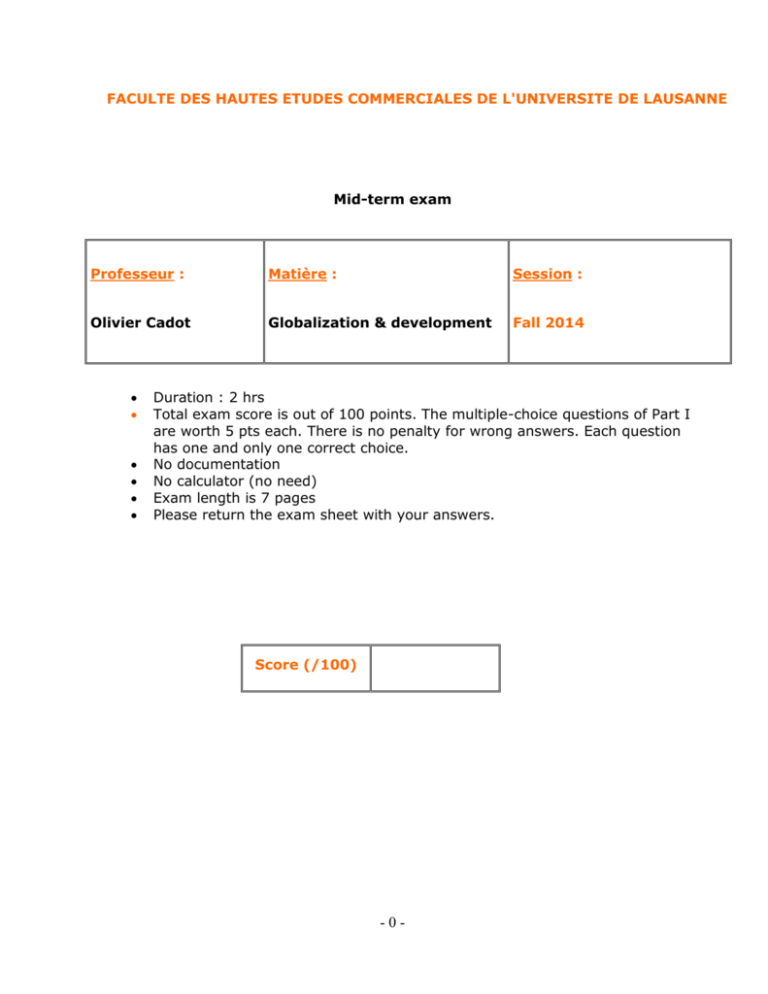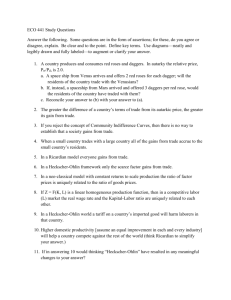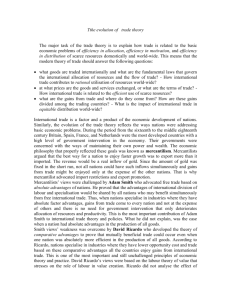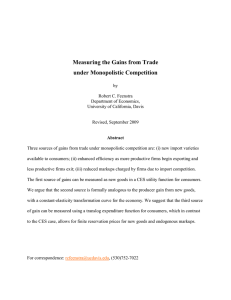mid-term 2014
advertisement

FACULTE DES HAUTES ETUDES COMMERCIALES DE L'UNIVERSITE DE LAUSANNE Mid-term exam Professeur : Matière : Session : Olivier Cadot Globalization & development Fall 2014 Duration : 2 hrs Total exam score is out of 100 points. The multiple-choice questions of Part I are worth 5 pts each. There is no penalty for wrong answers. Each question has one and only one correct choice. No documentation No calculator (no need) Exam length is 7 pages Please return the exam sheet with your answers. Score (/100) -0- Question 1 You have just been hired by a consulting firm and assigned to work with the Asian desk. Your boss will meet Myanmar’s Minister of Trade tomorrow. Myanmar is slowly opening up after years of U.S. and E.U. sanctions during which the economy was largely closed. The Minister is well trained (he has a doctorate in international relations) but his university days are a long time ago. He wants a brush-up on what modern theory has to say about the gains from international trade. Please provide a summary of the sources of gains from trade (i) in a Heckscher-Ohlin model; (ii) in a monopolistic-competition model. Be as precise as possible about the logic of the results while being comprehensible for a non-specialist. In order to guide you, your proposed note is decomposed below in sections graded separately. 1. Explain the sources of gains from trade in a Heckscher-Ohlin model, and how they relate to the model’s logic and assumptions (20 points) A Heckscher-Ohlin model is a trade model where production (value added) requires several factors of production (labor, capital and possibly human capital as well). In a Heckscher-Ohlin model, the gains from trade come from o The arbitraging of differences between domestic relative prices and international relative prices o Specialization of the domestic production structure. The gains are generated by the combination of differences in factor endowments (e.g. one country being more capital-abundant) and differences between factor intensities (one industry being more capital-intensive). With two countries, two factors and two industries, the country that is more capital-abundant will specialize in the capital-intensive industry and the one being less capital-abundant will specialize in the labor-intensive industry. Because the production function displays diminishing returns in each factor, specialization will not be complete (unlike in a Ricardian model). The gains from arbitraging price differences entail no adjustment cost. By contrast, the gains from specialization imply shrinking production in the sector where the country does not have a comparative advantage. In the model, this process takes place as a smooth movement along the production possibility frontier, with no friction or adjustment cost. This reflects nothing other than the assumption of permanent full employment; it is an assumption, not a fact of life. In reality, plant closures in one sector do not automatically create jobs in other sectors, and adjustment costs can be considerable. They are rubbed in the carpet by trade economists simply because the profession has never bothered measuring them; but it doesn’t mean they do not exist. -1- 2. Explain the sources of gains from trade in a monopolistic-competition model, and how they relate to the model’s logic and assumptions (15 points) In a monopolistic-competition (MC) model, unlike in Heckscher-Ohlin each firm produces a different variety, and production is characterized by economies of scale. In autarky, each consumer has the choice between the varieties produced by home firms. Consider trade liberalization between two countries that are identical in factor endowments and size. In a Heckscher-Ohlin model, there would be no gains from trade and in fact no trade at all, since relative autarky prices would be equal in the two countries. However, in a MC model, liberalization makes country A’s varieties suddenly available to consumers in country B. Thus, the number of varieties grows, which generates welfare gains. In addition, trade liberalization makes competition tougher, which reduces profit margins. This in turn reduces the number of firms. As a result, each surviving firm produces more, which in the presence of economies of scale reduces costs. The tougher competition forces firms to pass on those efficiency gains to consumers, so prices are reduced. Therefore consumers gain not only from having access to more varieties, but also from lower prices. 3. What can you say about the adjustment process as trade is liberalized? Will some firm exit? Which ones ? Please differentiate between the case of (i) a Heckscher-Ohlin model, (ii) a monopolistic-competition model, and (iii) a monopolistic-competition model with heterogeneous firms. In this last case, can you think of a conflict between the effect of trade liberalization and other government policies frequently adopted? (15 points) In a HO model, as already argued, the adjustment cost will be borne by the shrinking sectors. So firms will exit if they produce in a sector in which the country does not have a comparative advantage. In a MC model, we know that firms will exit but we don’t know which ones, since there is no comparative advantage (the two countries are identical). So we know there will be an adjustement cost, but it is hard to discuss it since who will bear it is indeterminate in the model. Things become clearer in a MC model with heterogeneous firms. We know that trade liberalization makes the demand more elastic but at the same time reduces the “choke price” (the vertical intercept of the demand curve). If firms are heterogeneous in terms of marginal cost, the ones with a marginal cost above the choke price will exit. Those are also the smallest, since firms with high marginal costs produce less than others. At the same time, because demand becomes more elastic, large, surviving firms will produce more. Thus, the market structure becomes more concentrated. This concentration is not bad in the sense that it does not reflect more market power (in fact, -2- there is less than before), but if the government somehow values the existence of small firms (many governments have programs supporting explicitly SMEs), trade liberalization may mean their sudden death. 4. Explain how dynamic gains from trade liberalization (in the form of a growth acceleration) can be explained in a simple Solow growth model. (10 points) The story is a bit of a footnote in a growth model. Essentially the argument is that in a Solow model it is real investment that matters for real growth, while the savings = investment constraint applies to nominal investment. If the government imposes an import duty on imported machinery, a given amount of savings will buy less investment in real terms (given the higher price of machinery). This will slow down growth. If the closed economy assumption is relaxed, then clearly investment can be more than national savings for a country borrowing on global financial markets (typically the case for developing countries). The argument is then weaker, but it still remains that a given amount of borrowing will buy less investment in the presence of a tax on imported machinery. Note that if the government is using the proceeds of import duties to invest in pro-growth infrastructure (education, energy, roads, etc.) the argument collapses. The argument was made by Estevadeordal and Taylor (2010) who showed empirically that countries that liberalized imports of capital and intermediate products during the Uruguay Round enjoyed a growth acceleration compared to a control group who did not, so the argument seems to hold some truth. -3- Question 2 (multiple-choice) Each multiplie-choice question is worth 5 points. Please mark your answer on the grid provided at the end of this exam. 1. Adjusting GDPs for purchasing-power parity is necessary a. b. c. d. When service prices differ between countries When the price of tradable goods differ To take into account inflation differences None of the above 2. The share of OECD countries in world GDP evaluated at PPP is. a. b. c. d. About three quarters Close to 90% Below 40% About half 3. Cultural distances as measured by differences in responses to World Values Survey questions have been a. Roughly constant except for some country pairs where they have been decreasing. b. Roughly constant except for a core of country pairs where they have been increasing. c. Decreasing massively for all country pairs, apparently for the first time in history d. None of the above. 4. Estimating trade in value added requires a. Complete input-output tables but nothing else. b. Input-output tables augmented by the uses of exports (as intermediates absorbed in the destination country, as intermediates for further export, etc.) which is typically not available in trade statistics. c. Input-output tables augmented by firm-level data on value added by product. d. None of the above. 5. When measured in value added, the US trade deficit is: a. Higher with Japan but lower with China, compared to the US trade deficit with the same countries but measured in « gross trade » b. Higher with both Japan and China c. Higher with China but lower with Japan d. The answer depends on whether the exchange rate is measured at PPP or not. 6. Export marketing boards have been used in many countries, both developing and industrial, to protect farmers in export sectors against exploitation by foreign intermediaries (they imply the centralization of the crop by an agency dealing bilaterally with intermediaries). Typically, their presence has been associated with a. Higher farmgate producer prices -4- b. Lower farmgate producer prices c. Unchanged farmgate producer prices d. Had no effect in sub-Saharan Africa as farmers ignored them and sold directly to intermediaries even in their presence. 7. When Wacziarg and Welsh (2008) re-estimated Sachs and Warner’s regression on a different time period, but using the same cross-sectional approach, a. They found that the effect was unchanged, but biased because of unobserved heterogeneity in the absence of fixed effects b. They found a stronger effect, but again biased for the same reason c. They found no effect at all, suggesting instability of the estimates d. They did not run Sachs and Warner’s regression on a different time period ; they simply switched from a cross-section to a panel estimation approach. 8. In the sample period covered by Macmillan and Rodrik (2011), differences in average productivity growth between Asia and Africa a. b. c. d. Are explained primarily by differences in within-sector productivity growth Are explained primarily by differences in employment shifts across sectors Don’t need to be explained since they are very small (there is no « East Asian miracle ») Are explained primarily by differences in the business environment (logistics costs, corruption and administrative procedures) 9. In absolute terms (number of people) the number of poor in the world a. Has been increasing since the beginning of the industrial revolution, then decreasing so rapidly during the last twenty years that the millennium development goal of halving poverty by 2015 has already been passed a while ago b. Has been constantly increasing since the beginning of the industrial revolution c. Has been constantly decreasing since the beginning of the industrial revolution d. Has been roughly constant over the last hundred years, implying a decreasing incidence (rate) of poverty -5- How to answer the multiplie-choice questions Please circle the correct response Examples of correct format (assuming b is the correct choice): 0. a b c d 0. a b c d Examples of incorrect format (assuming b is the correct choice): 1. a b c d 1. a b c d 1. a b c d 2. a b c d 3. a b c d 4. a b c d 5. a b c d 6. a b c d 7. a b c d 8. a b c d 9. a b c d Answer grid: -6-










